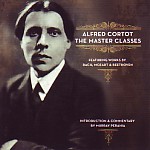Alfred Cortot founded the École Normale de Musique in 1919, where he taught master classes in piano interpretation until his death in 1962. Between 1954 and 1960 an engineering student named Pierre Thouzery, with Cortot’s permission, taped about 30 hours’ worth of classes, mainly preserving the pianist’s comments and extensive demonstrations at the keyboard. When Murray Perahia learned about the tapes from Cortot’s son Jean, he contacted Thouzery and subsequently proposed that Sony Classical release at least some of the classes for general audiences. Perahia has culled three discs of material that not only covers a wide repertoire range but also preserves Cortot in many works he did not commercially record. It should be made clear that Cortot demonstrates rather than performs, and only rarely do his excerpts spill over into extensive chunks. And given the informal, non-performance setting, it’s not surprising that Cortot plays more than his usual share of wrong notes.
But if you follow Cortot’s not-always-audible voice along with the French texts or their English translations, you get a stronger sense of what he wishes to impart. He stresses Bach’s B-flat Partita as a collection of dances rather than virtuoso vehicles, and looks upon Mozart’s C minor Fantasy K. 475 as a mirror to Don Giovanni. Despite the casual air about Cortot’s playing, you easily infer his knowledge and authority, especially when he’s free-associating.
For instance, he compares the mood of the finale to Mozart’s K. 310 A minor sonata with its later counterpart in Beethoven’s Tempest, while likening the melodic intensity and subtle syncopations in the first movement of Beethoven’s Op. 101 sonata to the Prelude of Wagner’s Tristan und Isolde. Cortot particularly waxes poetic on the subject of Chopin’s Ballades, although he also gives specific instructions regarding tone color, dynamics, and balances between hands. The fearless intensity he brings to Chopin’s C-sharp minor Scherzo makes you wish he had recorded this work in his prime.
While this release is not suited for casual listening, it still bears the imprint of Perahia’s caring and considerate editorial input, making it all the more valuable to piano students and Cortot aficionados. In an increasingly cautious climate among major labels, it’s heartening to see Sony Classical support a specialized project of this kind.
































